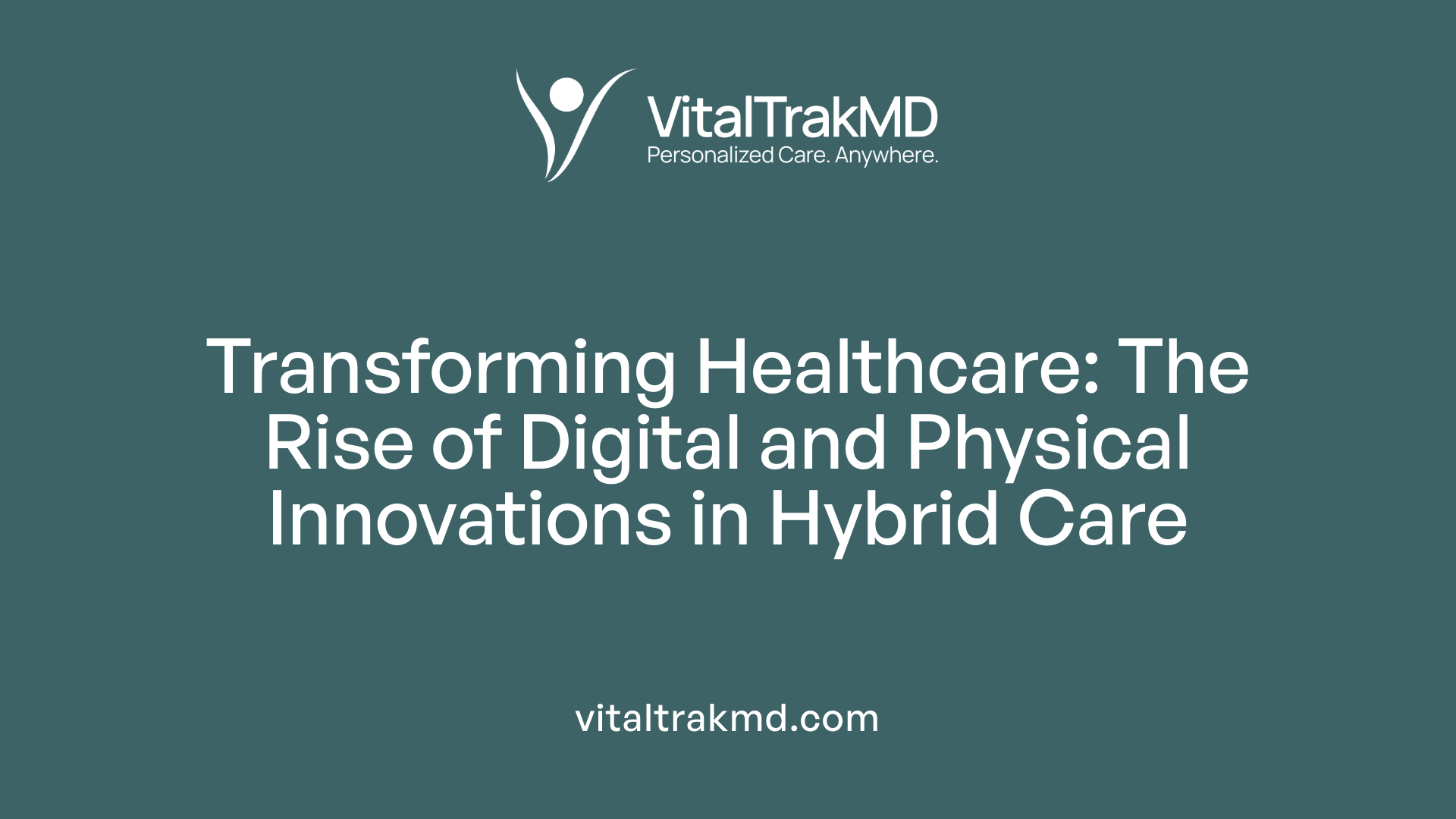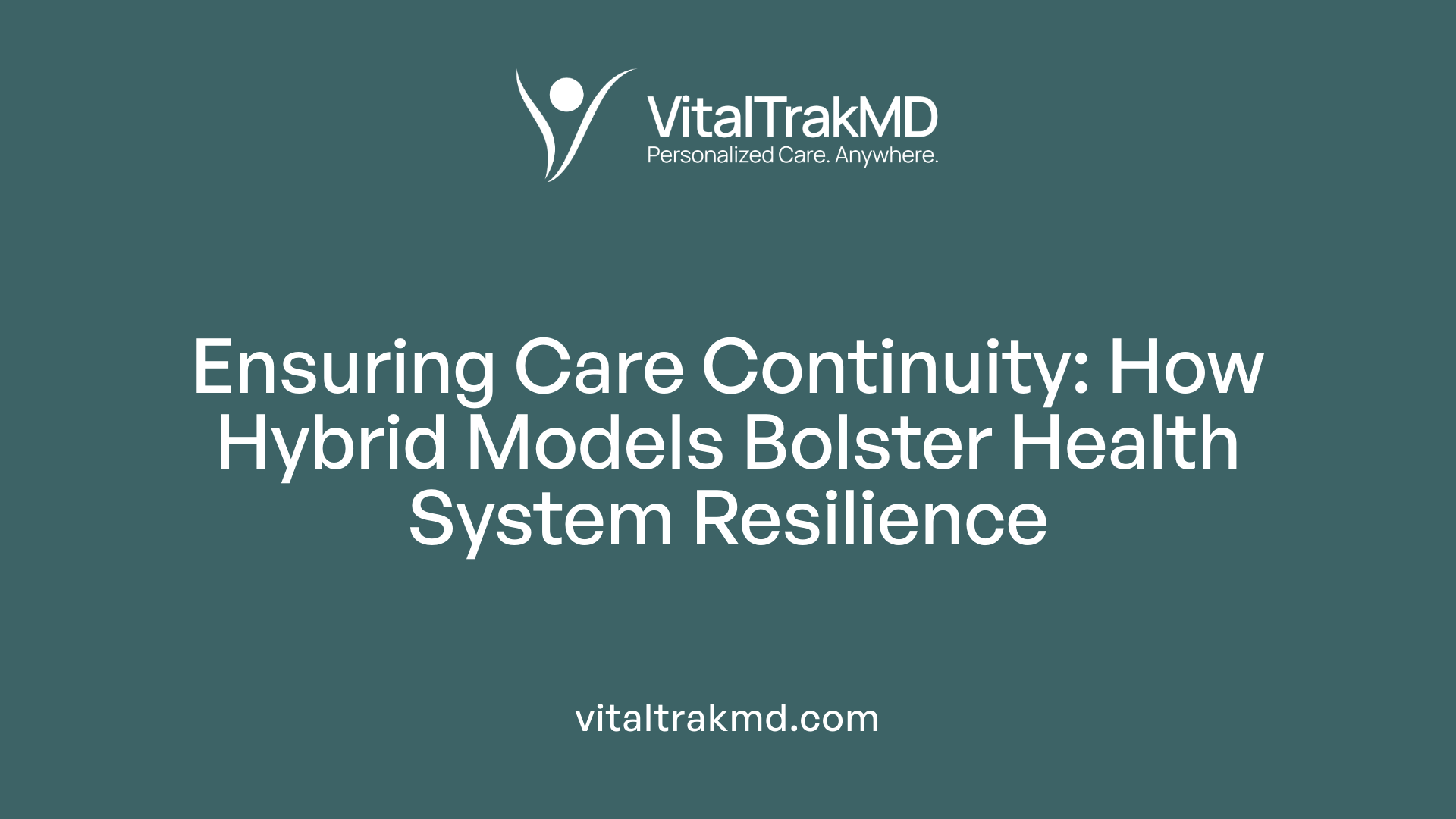The Role of Hybrid Care in Creating Predictable Health Check-In Schedules

Understanding Hybrid Care and Its Growing Importance
The rapid digital transformation propelled by the COVID-19 pandemic has significantly redefined healthcare delivery. Hybrid care models, which blend traditional in-person treatment with innovative virtual health services, have emerged as vital tools in creating predictable, efficient, and patient-centered health check-in routines. By seamlessly integrating physical and digital interventions, these models enable healthcare providers to enhance scheduling accuracy, improve patient engagement, and optimize resource utilization. This article explores the multifaceted role of hybrid care in establishing consistent health check-in schedules, examining operational benefits, technological innovations, and future prospects.
The Evolution of Hybrid Healthcare Models
How did the development of hybrid care evolve after COVID-19?
The COVID-19 pandemic acted as a catalyst for the rapid adoption and development of hybrid healthcare models. Healthcare systems worldwide, facing unprecedented staff shortages and increased patient demand, turned to digital solutions to sustain and enhance patient care. Hospitals and clinics integrated telehealth platforms, remote monitoring tools, and innovative physical space designs to enable more flexible, patient-centered care delivery.
One notable example is Sheba Medical Center in Israel, which created Sheba Beyond — the country's first virtual hospital. This facility supports hybrid care services such as remote chronic disease management, virtual clinics, and hospital-at-home programs, allowing patients to receive hospital-level care from their homes.
Remote monitoring technologies like TytoCare devices, vital sign sensors, ECGs, and portable X-ray units made it possible to manage patients remotely, reducing the need for physical hospital visits. During a pilot at Sheba, 452 patients benefited from an average stay of 3.5 days, illustrating the model's effectiveness.
How is digital transformation being implemented in hospital settings?
Hospitals have redesigned their physical environments to accommodate hybrid models, making them more adaptable and flexible. Features such as modular spaces, system separation, and dedicated control centers facilitate seamless integration of physical and virtual care.
In addition, digital infrastructure plays a critical role. Telemedicine platforms, remote patient monitoring systems, and remote examination devices ensure healthcare providers can deliver care outside traditional settings. However, these innovations come with challenges, including system integration issues and the need for staff training.
To support this shift, hospitals also develop specialized workflows. Efficient patient scheduling, digital registration, automated reminders, and two-way communication channels help streamline patient flow and improve overall service quality.
How are remote and physical care integrated within hybrid models?
Hybrid care categorizes pathways into four modes: inpatient, home hospitalization, inpatient telemedicine, and tele-home hospitalization. This classification allows for tailored, flexible treatment plans aligned with individual patient needs.
The design of hospital units now incorporates virtual beds—care spaces equipped with remote monitoring and digital tools—reducing physical bed capacity while maintaining high-quality care. This approach increases healthcare system resilience, especially during crises.
Clinicians leverage telehealth platforms, remote monitoring devices, and virtual triage to deliver continuous and personalized care. These methods not only improve patient safety and satisfaction but also help mitigate hospital-acquired infections.
The future of hybrid healthcare depends on further integration of control systems, digital infrastructure enhancements, and ongoing research into care quality, security, and stakeholder experiences. This evolution aims to sustain flexible, patient-centered, and efficient healthcare delivery.
Innovations in Digital and Physical Infrastructure for Hybrid Care

Why is hybrid care significant in maintaining consistent health check-in routines?
Hybrid care plays a crucial role in helping patients keep up with regular health check-ins by offering a mix of in-person and virtual services. This flexible approach makes healthcare more accessible, especially for those who face challenges with transportation, mobility, or living in remote areas.
With hybrid models, patients can easily connect with healthcare providers through virtual consultations, remote monitoring devices, and online health resources. This continuous engagement encourages adherence to routine check-ins and allows for early detection of health issues before they escalate.
Technology such as telehealth platforms, chatbots, and home monitoring tools enable real-time tracking of vital signs and symptoms. These innovations support timely interventions, reducing the need for repeated hospital visits and improving overall health outcomes.
During disruptions like the COVID-19 pandemic, hybrid care ensures ongoing patient-provider contact, maintaining care continuity despite social distancing and other restrictions. It also addresses disparities in healthcare access by reaching underserved populations who might otherwise struggle to access traditional in-person care.
Ultimately, hybrid care increases convenience and responsiveness, making routine health monitoring sustainable and adaptable to individual patient needs. Through continual technological advancement and infrastructure development, hybrid models will further streamline health check-in routines and improve long-term patient engagement.
Hybrid Care Pathways and Patient-Centered Flexibility

What are the different pathways within hybrid healthcare?
Hybrid healthcare encompasses several pathways that blend traditional in-person care with virtual services. These include inpatient care, where patients stay in physical hospital beds; home hospitalization, which allows patients to receive hospital-level care at home supported by remote monitoring technologies; telemedicine pathways, involving virtual consultations through video or phone; and tele-home hospitalization, which combines remote monitoring with occasional in-person visits.
This variety of pathways provides a comprehensive system that caters to different patient needs and medical conditions. For example, patients with chronic diseases might be managed through remote monitoring combined with periodic in-person assessments, while those recovering from surgery could benefit from virtual follow-up clinics.
How does hybrid healthcare influence scheduling and patient follow-up planning?
Hybrid healthcare dramatically alters how schedules are organized. By integrating digital tools and flexible workflows, healthcare providers can optimize appointment management. Automated reminders, real-time updates, and standardized protocols facilitate coordination between virtual and face-to-face visits.
Clinicians can set designated days or times for telehealth consultations and in-person appointments based on patient needs. This approach helps reduce appointment delays, minimizes long wait times, and decreases missed visits.
Proactive follow-up becomes more efficient through remote monitoring, digital communication channels, and data collection. These tools enable continuous patient engagement and timely interventions, which are crucial for managing chronic or complex conditions.
Overall, hybrid models streamline scheduling, make resource utilization more efficient, and foster a personalized approach to patient care, ensuring follow-ups are timely and suited to individual circumstances.
How are care pathways categorized in hybrid models?
Care pathways in hybrid healthcare are typically categorized into four primary modes:
| Mode | Description | Clinical Focus | Benefits |
|---|---|---|---|
| Inpatient | Traditional in-hospital treatment | Acute and severe conditions | Intense monitoring, immediate intervention |
| Home Hospitalization | Hospital-level care at home | Chronic disease management, recovery | Reduced hospital stays, comfort of home |
| Inpatient Telemedicine | Remote consultation within hospital | Post-op or complex case reviews | Flexible, quick specialist input |
| Tele-home Hospitalization | Remote care combined with home visits | Chronic and long-term care | Continuous monitoring, minimized hospital visits |
This structured categorization allows healthcare systems to tailor the care environment to the needs of each patient, combining the benefits of physical and virtual care modalities to enhance overall health outcomes.
Enhancing Operational Efficiency and Patient Outcomes
Staffing models with virtual nurses
Hybrid healthcare incorporates virtual nurses to handle administrative and remote patient care tasks such as admissions, discharges, patient education, and documentation. These virtual nurses work from remote locations, freeing physical bedside nurses to focus on direct patient care, thereby increasing workflow efficiency.
During peak periods, such as seasonal surges, on-demand nurses are deployed to provide bedside support as needed, ensuring staffing levels meet patient demand without overextending staff. This flexible staffing approach maintains quality care while managing workload and reducing staff burnout.
Virtual nursing has shown to contribute to shorter hospital stays—by over 7%—and decrease readmission rates by around 2%. This integration supports staff retention, improves overall productivity, and sustains a resilient healthcare workforce.
Impact on patient hospital stays and readmissions
The hybrid approach enables continuous, remote monitoring of patient conditions, facilitating early detection of deterioration and timely intervention. By supporting post-discharge follow-up and chronic disease management remotely, healthcare providers can effectively reduce unnecessary hospital admissions and readmissions.
The case of LifeBridge Health’s Center for Virtual Care illustrates how virtual services like Remote Patient Monitoring and virtual clinics enhance patient safety, improve health outcomes, and minimize hospital stays. Remote care delivers comparable quality using technology, which proves especially vital during health crises, like the COVID-19 pandemic.
These models also increase patient satisfaction and safety by enabling extended access to care, faster response times, and personalized treatment pathways, all contributing to better recovery rates and reduced healthcare costs.
Technology-driven scheduling efficiencies
Efficient scheduling workflows are critical for successful hybrid healthcare delivery. Digital registration systems, automated appointment reminders, and two-way communication platforms streamline patient interactions, reduce no-shows, and optimize appointment slots.
Integration of telehealth with existing scheduling and electronic health records (EHR) systems ensures seamless transitions between in-person and virtual visits, enhancing the patient experience while maximizing resource utilization. These digital tools support flexible appointment times, including outside regular hours, which improve access for patients with transportation or mobility issues.
Furthermore, real-time data sharing and coordinated workflows among care teams enable rapid response and better resource allocation, reducing bottlenecks and improving overall throughput.
| Aspect | Effect | Additional Details |
|---|---|---|
| Virtual nurses | Enhance efficiency, reduce inpatient stays | Handle remote admin tasks, patient education, documentation |
| On-demand bedside nurses | Improve surge capacity and staffing flexibility | Fill staffing gaps during seasonal peaks |
| Digital scheduling | Increase patient flow, reduce no-shows | Automate reminders, real-time updates |
| Data integration | Facilitate care transitions, improve coordination | Share patient info securely across platforms |
This comprehensive approach not only optimizes care delivery but also creates a more resilient and adaptable healthcare environment. It helps to address workforce shortages and increases the capacity for high-quality, personalized patient care, particularly in times of increased demand or health crises.
The Impact of Hybrid Care on Care Continuity and Resilience

Why is hybrid care significant in maintaining consistent health check-in routines?
Hybrid care plays a crucial role in ensuring patients maintain consistent health monitoring and check-in routines. Its flexible nature combines traditional in-person visits with digital health solutions such as telemedicine, remote patient monitoring, and online health portals. This fusion diminishes common barriers like transportation difficulties and geographical remoteness, making it easier for patients to stay engaged with their healthcare providers.
Through virtual consultations, patients can receive timely advice, medication adjustments, and early warning signs detection without the need to travel. Remote monitoring devices, like wearable sensors and home diagnostic tools, enable continuous oversight of chronic conditions—for instance, blood pressure, blood glucose, or heart rate—facilitating early intervention when needed.
Furthermore, digital tools such as chatbots, appointment scheduling apps, and online health records keep patients engaged and informed, encouraging adherence to health routines. This ongoing engagement is especially vital for managing chronic illnesses, post-surgical recovery, and preventive care.
During disruptions like the COVID-19 pandemic, hybrid care proved instrumental in maintaining healthcare continuity. It allowed health providers to monitor and support patients remotely, reducing the risk of hospital-acquired infections and avoiding unnecessary hospital visits. The model increases health system resilience by enabling rapid adaptation to various crises, ensuring patients receive necessary care without overburdening healthcare facilities.
Supporting vulnerable populations is another benefit of hybrid healthcare. Rural residents, the elderly, and mobility-challenged individuals gain improved access to consistent health services. By leveraging widespread internet access and smartphone technology, hybrid care bridges gaps in healthcare delivery, improves adherence, and enhances overall health outcomes.
In summary, hybrid care sustains ongoing health routines through accessible, personalized, and adaptable digital services. It not only enhances individual health management but also bolsters healthcare system resilience, especially in times of crisis, ensuring that vulnerable populations continue to receive essential care.
Future Directions and Challenges in Hybrid Healthcare

How does hybrid healthcare influence scheduling and patient follow-up planning?
Hybrid healthcare profoundly impacts how providers manage scheduling and follow-up care. It leverages digital tools and adaptable workflows to streamline appointment coordination. Automated reminders, real-time updates, and standardized protocols help optimize both virtual and in-person visits, reducing delays and missed appointments.
By assigning specific days or time slots for telehealth or physical visits, healthcare teams can create an efficient, patient-centric schedule that caters to individual needs and preferences. Digital platforms also facilitate proactive follow-up strategies—such as remote monitoring and digital communication channels—to ensure continuous engagement and care continuity.
This approach not only improves resource use but also enhances patient experience by making healthcare more accessible and timely. Overall, hybrid models foster a more organized, flexible way to plan patient interactions while maintaining high standards of individualized care.
Technological advancements
Future developments in hybrid healthcare will likely focus on advanced telehealth devices, artificial intelligence (AI), and integrated electronic health record (EHR) systems. Wearable sensors, remote diagnostic tools, and AI-driven analytics can provide real-time health insights, enabling personalized treatment plans.
Enhanced digital infrastructure, including 5G connectivity and cloud-based platforms, will ensure seamless, secure data sharing and remote consultations. Emerging technologies like virtual reality (VR) and augmented reality (AR) could further support remote diagnostics and training.
Addressing digital divides
To ensure equitable access, future efforts must address the digital divide, which affects underserved populations with limited internet access or technology literacy. Solutions may include expanding broadband infrastructure, providing affordable devices, and implementing digital literacy programs.
Healthcare organizations might also develop simplified user interfaces and multilingual support to accommodate diverse patient demographics.
Research and quality improvement
Ongoing research will focus on assessing the safety, quality, and patient satisfaction within hybrid models. Developing standardized metrics and benchmarks can help monitor effectiveness and identify areas for improvement.
Quality assurance involves continuous feedback from patients and clinicians, fostering a culture of iterative refinement. Integration of performance data with clinical outcomes will enable data-driven decisions to optimize hybrid care pathways.
| Aspect | Focus | Future Outlook |
|---|---|---|
| Technology | AI, wearables, 5G | Personalized remote diagnostics and seamless data flow |
| Access | Bridging digital gaps | More equitable healthcare delivery |
| Quality | Metrics, feedback | Evidence-based improvements in care and safety |
Hybrid healthcare is poised to become increasingly sophisticated, combining innovative technology with strategic system design to create more flexible, accessible, and effective care environments, despite existing challenges.
Empowering Healthcare through Hybrid Innovation
As healthcare continues to evolve, hybrid care models stand at the forefront of creating predictable, flexible, and efficient health check-in schedules. Combining the agility of digital technology with the trust of in-person care not only enhances operational efficiency and patient satisfaction but also strengthens the resilience of healthcare systems. Embracing innovations in remote monitoring, virtual staffing, and flexible infrastructure will be pivotal in sustaining these benefits. Moving forward, addressing challenges such as technology access disparities and maintaining quality standards will be necessary to fully realize hybrid care's potential in delivering consistent, accessible, and high-quality healthcare for all populations.
References
- Designing for flexibility in hybrid care services - PubMed Central
- What is a Hybrid Patient Care Model and How to Implement It
- Hybrid Schedules Are Key to Physician Recruitment and ...
- How the Hybrid Care Model is Transforming Patient Access
- What Is Hybrid Healthcare? | Tools, Benefits, and Solutions
- Is Hybrid Telehealth Model the Next Step for Private ...
- What Is a Hybrid Care Model? How Virtual Nursing and ...
- What is Hybrid Patient Care Model in Healthcare: Full Guide
- The Future of Health Care Is Hybrid
- What is a hybrid model of healthcare?
Recent articles
Want to Feel Better and Live Healthier?
Join hundreds of patients taking control of their health with personalized care that fits their life – not the other way around.
Rated 4.8/5 by 32+ customers







